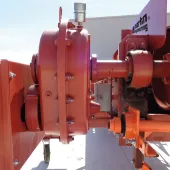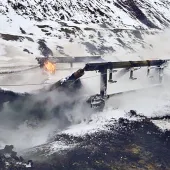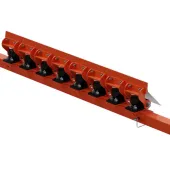Five Steps to the Successful Adoption of Smart Technology

First published in the June 2021 issue of Quarry Management as Reluctant to Tie the Knot with Tech?
Smart technology is optimizing manufacturing in almost every industrial sector, so why are some companies still reluctant to commit? Robert Whetstone, vice-president of Europe, Middle East, Africa and India with Martin Engineering, outlines five steps to the successful adoption of smart technology
The Internet of Things (IoT) has numerous definitions but can be summarized as ‘the interconnection, via the Internet, of electronic devices integrated into everyday objects that enables them to send and receive data over a wireless network without human intervention’. Many readers will be familiar with examples of smart devices in daily life, and the same technology is already revolutionizing many aspects of business and commerce.
IoT solutions have been available in manufacturing for at least 10 years, yet the adoption of potentially game-changing technologies in sectors such as quarrying and materials processing is painfully slow. When Martin Engineering began developing their N2 remote monitoring solution to allow condition-based predictive maintenance on conveyor belt cleaners, part of the company’s mission was to find out why there was such reticence in the market to adopt innovative tech.
It soon became clear that five key challenges would need to be overcome, none of which were to do with the IoT technology itself, but more about the approach often taken by proponents of technology, combined with the innate scepticism of operations managers in a very traditional industry.
To create a true ‘win-win’ business model in which smart equipment suppliers deliver tangible value for materials producers, Martin Engineering realized that a fresh approach would be required. Only when the proposition is attractive for everyone involved, including site operations teams, company owners and service partners, will enough momentum be generated towards adaptation to new ways of working. The following are the five distinct areas that we looked at:
1. Address the real ‘pain points’
First, we started with the actual ‘pain points’ being experienced by operations teams in our sector of the industry – the everyday problems that cause hassle and waste time. We already work closely with our customers and have a good understanding of their challenges, but we are also fortunate that many Martin colleagues have years of experience working as operations managers in mining and quarrying.
It was clear from our exploratory work that many technological solutions falter because they do not address real pain points, or developers fail to explain how they address pain points or, even worse, they introduce new pain points. Technology for technology’s sake is of little value without beneficial application in the real world. It was critical for us, therefore, to challenge ourselves to be certain that the technology available was truly addressing the pain points and not merely hiding the pain or shifting it elsewhere.
2. Make it affordable and scalable
The first question we get asked by customers, and rightly so, is ‘Is it affordable and scalable?’ At Martin Engineering, we already know our belt cleaning systems are great at controlling spillage and carry-back, reducing clean-up and downtime, saving money on maintenance, and helping to improve health and safety. And over time we know that our products deliver a solid return in all these areas.
We also realize, however, that the belt cleaners themselves need managing, especially when there are numerous variables during initial installation, combined with the need for regular servicing and timely replacement, not to mention the changeability in the material properties, the condition of the belt, condition and age of the processing plant etc. All of these things must be understood and monitored to maximize the primary benefits of having belt cleaners installed in the first place.
Whilst our own technicians and approved contractors know this inside out, they cannot be on call everywhere all the time, and accommodating regular site visits can be problematic at busy production plants. Equally, the in-house maintenance teams at quarrying and material processing companies are often stretched, so inspecting belt cleaners on the off chance that some of them might need a service may not be the top of their list of priorities. That is until something goes wrong.
Therefore, we needed to come up with an easy, inexpensive way to remove the perception of extra burden and instead be able to monitor remotely and predict when servicing may be required. Our solution is extremely simple and cost-effective for all parties – unlocking the ‘win-win’ business model we were seeking.
3. Deliver actionable information
No matter how impressive any technology may be, when you are in the midst of developing an innovation, it is easy to forget that the outcome is what matters. But the only thing IoT technology can really deliver is data – and data alone does not achieve a better outcome.
While the age-old mantra ‘if you can measure it, you can manage it’ is true, any measurement data needs to support clear decision-making, not prompt new questions or debates. Essentially, data needs analysing and too much analysis can lead to paralysis. Businesses can become obsessed by data, over-analysing it rather than acting upon it.
Understanding this challenge, Martin Engineering have invested time and effort ensuring that the data from their N2 system is not only in real time, but is automatically analysed, interpreted and presented in a way which makes decisions straightforward. Hence, with the Martin mobile app and customer portal dashboard, users get a series of clear charts with actionable information; Martin’s approach being ‘if you can measure it more easily you can manage it more easily’.
4. Align with the direction of change
If companies need to change to adopt IoT solutions, they face a real barrier to advancement, which comes in two main forms: business processes can be rigid and established ways of working may have become ingrained over decades; and people may show huge resistance to change the daily routines they are familiar with.
In reality, introducing any technology is an exercise in change management – the easy bit is the technical and mechanical installation. The trick is to ensure the benefit of the change is well understood, and ultimately the new way of working must be less onerous than the current regime.
In Martin Engineering’s case, N2 technology virtually eliminates the need for belt-by-belt physical inspections; on a large quarry plant that could save hours each week, not to mention the reduced exposure to moving belts. For example, one area that we have worked to understand is the comparison between the effects of installing N2 with the effects of not installing N2. This allowed us to build an even more compelling case to convince people that the change – albeit modest – is well worth it.
Finally, if people are required to learn something new without understanding why they are being asked to change, some degree of resistance is likely and failure is probable. Resistance can also be diminished and overcome by ensuring any new technology is easy to use and designed to be intuitive and even enjoyable. Thus, an integral part of the N2 system is the Martin app which clearly shows blade life and only sends a notification when servicing is needed – a true win for the user.
5. Use existing technology and everyday language
From the outset, Martin Engineering knew that no company could justify further spending on upgrades to accommodate a new device like the N2 – even a small cost could mean the difference between adoption and non-adoption. It was essential, therefore, that the N2 position indicator was able to be retrofitted without additional upgrades to the plant. The device is also designed to be scalable across processing plants of all sizes, types and ages, without incurring additional cost, and can work with any number of conveyors on any plant.
Hand in hand with this comes the simplicity of installation – once the central Gateway is installed and powered up, each N2 position indicator can be fitted, calibrated and paired with the Gateway in just a few minutes. All the clever technical stuff – the data analysis and feed to the app and dashboard – is all done off site with the support of leading technology providers such as Amazon Web Services, so nobody at the processing plant needs to become an IT expert to make N2 work.
Finally: Listen to understand
In summary, Martin Engineering have taken the views of the materials producers and approached the market with a change management mindset. We did not just listen to our customers to record their feedback – we listened to understand so we could solve their problems. We have tried to take away the potential barriers that might otherwise be encountered with new technology and instead addressed each potential challenge with a solution.
Of course, the proof of the pudding is in the eating, and whilst the recent trials of N2 have been a huge success, we are not complacent – ultimately, it will be the uptake of this system that will show whether we have got it right. But the global pandemic of the past year has taught all of us that not only can remote working be achieved, but also that it can be achieved very efficiently and effectively given the right technology.
At Martin Engineering, we believe we have that ‘right technology’ and are at the forefront of the movement towards a generational shift towards remote monitoring and predictive, condition-based maintenance. The remote revolution is here to stay, and if our experience is anything to go by, it would be well worth getting on board.
- Subscribe to Quarry Management, the monthly journal for the mineral products industry, to read articles before they appear on Agg-Net.com








